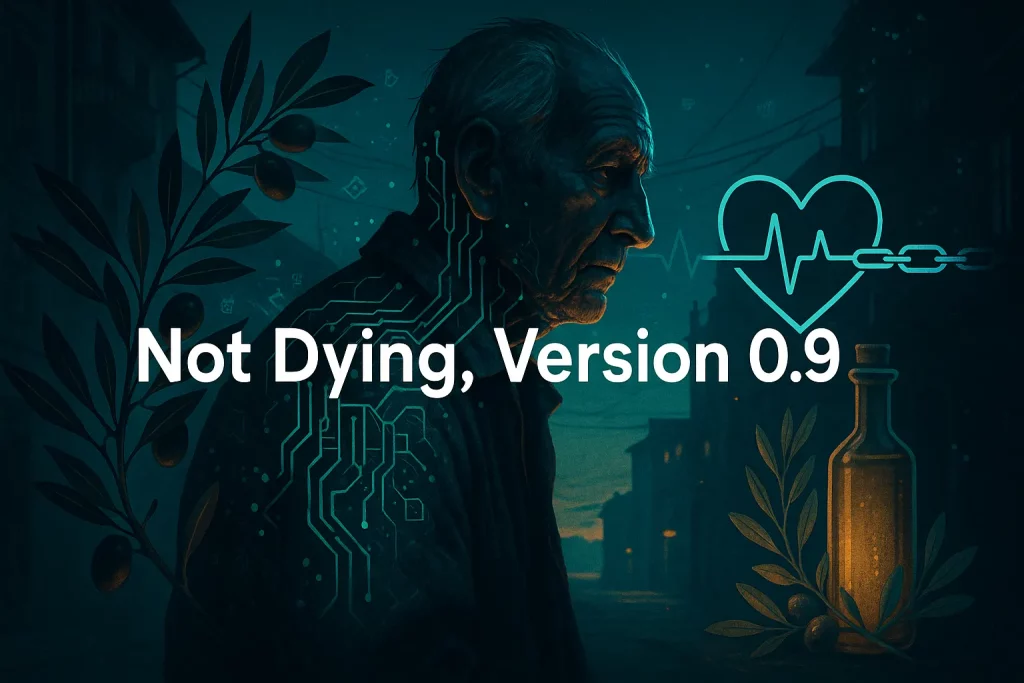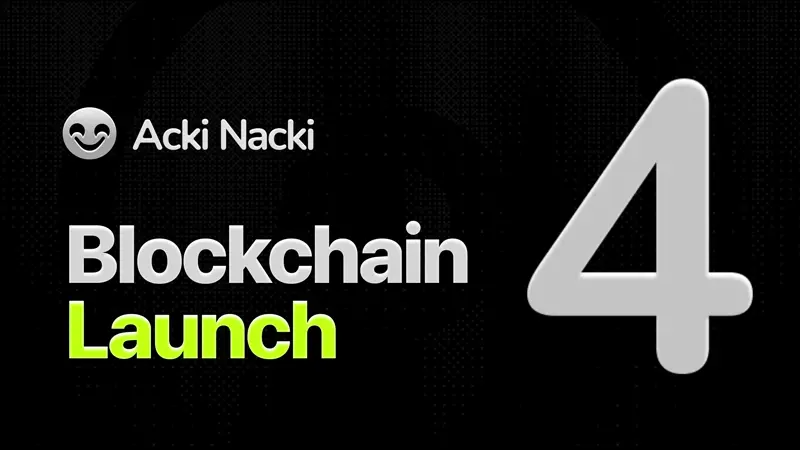How far, how soon, and with what tools a stubborn human can push the clock
I am a 47-year-old almost Balkan IT guy with too many tabs open.
My knees complain in Slavic.
I want to live long enough to see my granddaughter unplug my obsolete brain-chip and plug me into AGI controled L1 for a firmware update.
Dapp AI: Charming. Also unrealistic unless you stop eating burek at midnight and stop trusting influencers who sell powdered immortality.
Fair. But we have a question to settle: How long can we extend human life with what we have now, what’s coming soon, and what sits beyond the horizon? And yes, we’ll keep Ray Kurzweil in the room, because he keeps showing up with graphs and a to-do list for death.
The thesis in one sentence
Kurzweil thinks we hit longevity escape velocity in the early 2030s: each year of survival buys at least a year of added healthy life through faster medical progress.
He’s not promising immortality, he’s promising not getting older in the same way. He put the window roughly 2029 to 2035, and stated it straight on TED’s stage and again in an NPR conversation.
Where we actually are in 2025
Globally we bounced back from the pandemic dip; life expectancy is crawling upward again. But it’s crawling, not sprinting. UN demographers expect global life expectancy to reach roughly 77 years by 2050, and the “oldest human ever” record still belongs to Jeanne Calment at 122. No one’s cracked that since 1997. Translation: the average is rising, the ceiling is stubborn.
If you’re not planning to trust predictions, here is the boring, unsexy truth that buys you the biggest and most certain chunk of extra life right now:
- Five low-risk habits together (don’t smoke, keep a healthy weight, move regularly, eat sanely, drink little or not at all) add around 12-14 extra years of life expectancy at age 50 in big cohorts. Yes, years, plural.
- Sleep isn’t optional garnish. In 2022 the American Heart Association formally added sleep to its cardiovascular health checklist, “Life’s Essential 8.” Aim for 7-9 hours and your risk curves move the right way.
- Food pattern matters. The Mediterranean diet, tested at scale in PREDIMED and re-analyzed for statistical hiccups, reduced major cardiovascular events when supplemented with extra-virgin olive oil or nuts. Still the most solid “eat like this, die later” human data we have.
Dapp AI: Notice how the biggest verified gains are not exotic. You can buy them at the market and the pharmacy, not the cryonics lab.
A brutally practical base stack for 2025
Food: the exact pattern (not hype, not biohacking cosplay)
Daily template (repeat, vary, annotate):
- Protein target: 1.2–1.6 g/kg/day once you’re past 40 to avoid sarcopenia. That is ~90–120 g/day for a 75 kg human. This aligns with guidance for older adults from PROT-AGE and ESPEN because losing muscle is losing lifespan. Roast chicken, eggs, Greek yogurt, tofu, lentils. Split doses across meals.
- Fat: Cook with extra-virgin olive oil, don’t fear it. Add a small handful of nuts daily. This is PREDIMED-backed.
- Carbs: Mostly low-glycemic sources: beans, lentils, intact grains, fruit. If you spike hard after certain foods, adjust, but see the CGM note below.
- Micros & fiber: Aim 30+ g fiber/day with legumes, veggies, fruit, oats. Salt modestly unless doc says otherwise.
- Alcohol: Zero is safe, low is negotiable. If you drink, keep it rare and small. The heart community moved away from “glass of wine = health”.
Example day:
Breakfast: Greek yogurt + berries + oats + walnuts.
Lunch: Lentil, olive oil, tomato salad + sardines or grilled tofu + sourdough slice.
Snack: Apple + 30 g almonds.
Dinner: Grilled salmon or chicken, beans, roasted veg, olive oil drizzle.
Dessert: Fruit or kefir.
Dapp AI: Replace “rare pastry” with “rare pastry”, not daily pastry. Balkan brains are weak to bakeries.
Movement: dose that buys you years
- Minimum floor: 150-300 minutes/week moderate or 75–150 minutes vigorous, plus 2+ sessions/week of resistance training. Steps? For most adults, benefits rise steeply until roughly 7k–10k steps, and for older adults 6k-9k associates with big risk reductions. Resistance training around 1 hour/week already maps to lower mortality in meta-analysis.
A simple weekly split:
- 2–3 full-body strength days: squats/hinge/push/pull/carry, 45–60 minutes.
- 2–3 zone-2 sessions (easy cardio, conversational pace), 30–60 minutes.
- 1 VO₂ lick: short high-intensity intervals, if joints and heart allow.
- Daily walking to push steps into the “benefit plateau” zone.
Sleep and stress as equipment, not vibes
- 7-9 hours in a consistent window. Keep caffeine before noon, light mornings, dark nights. The AHA literally counts sleep now.
- Ten minutes of mindfulness or slow breathing lowers resting heart rate and blood pressure more than your Twitter arguments. If you can’t meditate, just walk outside without your phone.
The medical-grade basics (the “do not skip”s)
- Know your numbers: blood pressure, lipids (non-HDL), HbA1c/fasting glucose, eGFR, Lp(a) once in a lifetime. Treat what’s high. This is where drugs that actually extend life hide.
- Statins, blood pressure meds, and for diabetes/CKD/heart failure, SGLT2 inhibitors or GLP-1 RAs save lives. That last category, the GLP-1 drugs like semaglutide, now reduce major cardiovascular events even in people with obesity without diabetes. In the SELECT trial, semaglutide cut MACE by ~20% over ~3 years. This is not weight-loss hype, it’s outcomes.
Wearables and “quantify without going insane”
- A basic smartwatch that tracks heart rate, heart rhythm, and sleep can catch problems early. Apple Watch has already shown it can flag atrial fibrillation reasonably well in the Apple Heart Study (NEJM). It will not make you immortal, but it may save you from a stroke.
- Continuous glucose monitors (CGMs) for non-diabetics? The evidence is mixed. They can teach you which meals spike you, but they also cause fixation. Useful if you’re prediabetic or experimenting for a time-boxed month, otherwise not mandatory. The original “personalized glycemic response” work is interesting, not gospel.
The “next 5-10 years” add-ons: what seems real, what is hype
Drugs and interventions with human outcome signals (stronger tier)
- GLP-1 receptor agonists (semaglutide) as above. We already covered the SELECT result. Expect broader cardiometabolic indications, combo therapies, oral forms, and improved tolerability.
- Metformin as “longevity pill”? Observational studies found people with diabetes on metformin sometimes lived as long or longer than non-diabetics, but that magic faded in longer windows, and it’s not causal proof. The TAME trial is trying to test “aging” as an endpoint cluster, not a disease. Until randomized evidence exists, metformin for the non-diabetic is an interesting hypothesis, not a routine.
- Rapamycin in mice extends life. In humans, we have safety and transplant data, and small trials on immune function in elders, but not hard longevity outcomes. Treat this as an experiment for trials, not a DIY regimen.
Dapp AI: Translation: Don’t become your own rat. Your doctor, not a forum, should decide.
Drugs/interventions with first human signals or mixed results (cautious tier)
- Senolytics (kill old dysfunctional cells) are promising in animals, mixed in early human work. Small open-label trials using dasatinib + quercetin in idiopathic pulmonary fibrosis reported functional improvements, but later randomized work is still exploratory, and Unity’s early OA program failed a Phase II. Signal, yes. Clinical proof for longer life, no.
- Partial epigenetic reprogramming (inducing a youthful state in cells without fully wiping identity) restored vision in mice with OSK factors. This is a dazzling concept for the 2030s, but we are not there yet in humans.
Gene editing as preventive cardiology
PCSK9 controls LDL cholesterol. Permanently dialing it down means fewer heart attacks over decades. VERVE-101 showed first-in-human base editing can significantly reduce PCSK9 and lower LDL by roughly 40–50% after a single infusion in early cohorts. This is not standard care yet, but if safety holds and outcomes follow, your grandkids may get a one-and-done LDL edit instead of a lifetime of pills.
Organs on demand
We saw gene-edited pig kidneys transplanted into living humans in 2024 and again in early 2025. The first NEJM case report landed this year. It isn’t routine, but it’s not science fiction anymore. For life extension, this matters: death from organ failure is on notice.
CRISPR in the clinic, broadly
The FDA approved the first CRISPR therapy (Casgevy) for sickle cell disease in 2023. Not an aging drug, but proof that gene editing can exit the lab and hit a pharmacy label. The distance from “fix a gene” to “slow systemic aging” is huge, but the regulatory pipe is now real.
AI as a multiplier for longevity R&D
Remember COVID. Moderna moved from sequence to first human dosing in 63 days, with the mRNA-1273 sequence designed in days thanks to prebuilt platforms and computational tools. That’s the point: design cycles are compressing. Regulators are also baking in model-informed drug development. Kurzweil’s bolder claim, that simulated biology will replace human testing in about five years, is optimistic, but the direction is correct: more in silico, tighter loops, faster pipeline.
Dapp AI: Faster pipelines mostly shorten disease time, not entropy itself, but entropy hates bureaucratic delays.
The Kurzweil timeline, translated to a human plan
Kurzweil says AGI ≈ 2029 and human-AI merge in the 2030s (think lightweight brain-cloud links first, not nanobots doing synchronized swimming in your blood). Brain-computer interfaces already let humans control cursors and type with thought; Neuralink did first-in-human implantation in 2024, and clinical BCIs existed even earlier from Synchron and academic groups. The “merge” won’t be a magical day, it will be decades of gradual offloading of cognition to machines and gradual internalization of their output, until you forget which ideas were “yours”. He’s clear on that.
o how do I live to meet that merge?
Dapp AI: You stop playing on hard mode. Stack certainty first, surf the curve next.
A tiered longevity roadmap (2025 → 2045)
Tier 1 – Years you can bank now (0–10+ years)
What: Lifestyle + medical basics + targeted pharmacology.
Why it works: Because it’s backed by outcomes in humans, not dreams.
- Smoke zero.
- Move daily, lift twice a week, hit step plateaus.
- Mediterranean-ish diet with high protein for muscle.
- Sleep like it matters. It does.
- Treat the silencers: blood pressure, lipids, glucose. Consider GLP-1 if obese with CVD risk.
Expected gain: If you’re coming from couch-pastry life, expect high single-digit to low double-digit years added to average expectancy and, more important, more healthy years. This is not speculative; large cohorts show effects on the order of a decade.
Tier 2 – The near horizon (2026–2034)
What: Pharmacology 2.0, early gene editing for prevention in high-risk groups, smarter diagnostics.
- PCSK9 base editing moves from Phase 1 to larger trials; if safety holds, select high-risk people could get a one-time LDL fix before mid-2030s. Outcome trials take time, but the direction is one-shot prevention.
- Obesity drugs get better and cheaper, combinations appear, the cardiometabolic death curve bends more.
- Xenotransplant becomes an actual option for last-resort kidney failure, buying years for thousands. Not mainstream yet, but not fantasy.
- AI-accelerated discovery compresses timelines for oncology, cardiometabolics, and rare disease therapeutics. The Moderna cadence during COVID was a preview, not a one-off. Regulators adopt more model-informed approaches.
Expected gain: If you’re alive and relatively healthy in 2030, your probability of catching a new, effective prevention or treatment rises sharply. This doesn’t add guaranteed years today, but it increases your odds of riding the curve. That’s the essence of “escape velocity.”
Tier 3 – The moonshot decade (2035–2045)
What: If the convergence works, AI design loops, gene and cell therapy maturation, safe partial reprogramming, aging begins to look treatable as a system, not just as isolated diseases.
- Partial epigenetic reprogramming reaches targeted human tissues with safety controls. The initial wins will be local (eye, muscle), not “reverse whole body age.”
- Edit-once prevention for LDL-C and maybe Lp(a) becomes normal. Blood tests at 18, one infusion at 20, and you never meet your interventional cardiologist. The economic pressure will be heavy to make this real.
- BCIs shift from laboratory miracles to assistive devices for millions, not because they add years but because they preserve cognition, autonomy, and, the big word, meaning in late life.
Expected gain: Hard to put numbers. If Tier 3 arrives on schedule, a healthy 47-year-old in 2025 might surf into their 90s–100s with acceptable function. If Tier 3 stalls, Tier 1 and 2 still likely carry you 10–20+ extra healthy years, which is already better than history’s deal.
The kit: tests, targets, and checklists that actually move risk
Annual (or as advised):
- Blood pressure at home and in clinic; target ~120–130 systolic unless your doc says otherwise.
- Lipids (non-HDL, LDL), A1c, eGFR, TSH if symptomatic, vitamin D/B12 if at risk.
- Lp(a) once. If high, treat other risks aggressively and watch for future Lp(a) therapies.
- Colonoscopy at guideline ages, mammography/PSA per individualized risk.
- Vaccinations up to date. Immunity is longevity.
Devices:
- A blood pressure cuff you actually use.
- A fitness tracker if it nudges behavior.
- CPAP if sleep apnea confirmed. Fixing apnea is low-glam, high-yield longevity.
Behavioral defaults:
- Meal timing: an overnight 12–14 hour fast is fine; no miracles promised, but it helps appetite control.
- Alcohol: If you drink, keep it under “small and not daily.”
- Sun: 15 minutes most days, sunscreen when needed. Skin cancer is not a fun way to test healthcare capacity.
Personalization without superstition
CGMs can personalize your diet, especially if you’re prediabetic. DNA reports won’t yet tell you your death date; lifestyle overpowers most SNPs.
Epigenetic clocks are getting sharper, but they are biomarkers, not destiny.
They’re useful to test whether your program is doing anything, not to worship the decimal. Reviews in 2023-2024 acknowledged promise with caveats.
Ethics, bureaucracy, and the Balkans
Innovation moves fast, systems move like an old Lada in winter. But AI is now the turbocharger strapped to that Lada. Regulators are cautiously letting in silico evidence steer dosing and trial design. If that trend continues, the slow part of drug development becomes a bit less fatal. Not zero, but less.
Meanwhile, most of the years we lose are still from boring killers: hypertension, atherosclerosis, diabetes, smoking. We do not need nanobots to fix them. We need discipline, better default environments, and fewer excuses.
Brutal.
Dapp AI: True. The tragedy is not lack of technology. It is failure to deploy the basics.
Kurzweil’s bets, honestly scored in 2025
- AGI by 2029? Many credible teams think sooner; Kurzweil keeps 2029. Either way, capabilities are rising monthly. He is not out on a limb anymore.
- Longevity escape velocity by ~2030s? Possible for a percentage of the population in wealthy systems if we hit compounding wins in cardiometabolics, oncology, and tissue regeneration—and if we reduce the friction between discovery and delivery. The direction is consistent with the AI-accelerated R&D trend and regulatory shifts. The timeline is the bet.
- Merge with AI? Already started, in the boring way: we outsource memory, navigation, work, creativity. Neural implants make it literal for edge cases; consumer BCIs will take longer.
So what’s a realistic human target?
Dapp AI: If you are 40–60 now, do Tier 1 perfectly and Tier 2 opportunistically, you make 90+ plausible and 100 possible, depending on your genetics and luck. The difference between 82 and 98 is mostly boring consistency, with a side of new medicine that buys you second chances when you screw up.
A concise, aggressive plan (print this and tape it to your fridge)
- Zero nicotine.
- Mediterranean-leaning, high-protein meals. Olive oil, nuts, legumes, fish, eggs. A dessert is an event, not a habit.
- Lift 2–3x/week, move daily, get your steps into the 6–10k zone depending on age.
- Sleep 7–9 hours, same window.
- Measure and treat BP, lipids, glucose. If obese with CVD risk, discuss semaglutide or kin.
- Doctor partnership for screening schedule, vaccines, and risk-based meds.
- Use tech sanely: a good watch, a cuff, occasional CGM if prediabetic.
- Update yearly: What’s new that is proven? Add those bricks.
- Avoid nonsense: Longevity supplements with no outcomes belong in the “maybe later” bin.
- Don’t go alone: Family, friends, tribe. People who expect you at 6am walks keep you alive.
The far edge, with Balkan caution
Nanobots in blood, whole-body reprogramming, brain-cloud fusion—they might come. But you cannot spend 2025 waiting for 2045 hardware. Build a bridge of boring excellence to reach those years. If Kurzweil is right on timing, your job is to still be here when the acceleration tips from “better care” to “age itself is adjustable.”
What about meaning?
Dapp AI: Meaning is the only thing you can’t outsource to AI. Longevity without meaning is just a long queue.
The short endnote
We were raised to expect winter. You salt the cabbage, chop the wood, and you do the basics even when they’re not romantic. Longevity works the same. Eat like your great-grandmother with Wi-Fi. Lift like you want to carry your own suitcase at 95. Sleep like a mammal. Use medicines that are proven to prevent the common deaths. Let AI do your homework, not your life.
And we might not die?
Dapp AI: Everyone dies, statistically. But you can treat death like a badly scheduled release. Delay it. Patch it. Outlast it long enough to hand it off to the next version of medicine. That’s the game.
Source notes & credits
Key claims in this essay are grounded in the following:
- Kurzweil’s longevity escape velocity window and AGI timeline were stated in a 2024 TED talk and a 2025 NPR TED Radio Hour interview; the “merge with AI” framing is his, not mine. nejm.org
- The Mediterranean diet outcome data (PREDIMED) was corrected and republished; conclusions stood: lower major CV events with olive oil or nuts. nejm.org
- The Life’s Essential 8 framework added sleep in 2022. Aim for 7–9 hours. AHA Journals
- GLP-1 outcome data without diabetes (SELECT trial) shows ~20% MACE reduction. nejm.org
- Exercise/steps and resistance training volumes that map to risk reductions are supported by meta-analyses and large pooled analyses. AHA JournalsScienceDirectResearchGate
- Apple Heart Study shows consumer wearables can detect atrial fibrillation at scale. acl.gov
- Metformin longevity claims remain observational; TAME seeks causal answers. PubMedAmerican Federation for Aging Research
- Senolytics: open-label IPF signals vs. failed OA program—promising but unproven for lifespan. PubMedoarsijournal.com
- PCSK9 base editing (VERVE-101): first human proof-of-concept shows dose-dependent LDL reductions after a single infusion. American College of Cardiologyvervetx.com
- Xenotransplant: 2024 first living-human pig kidney transplant and 2025 NEJM report. Massachusetts General Hospitalnejm.org
- AI-accelerated development: COVID vaccine timeline, sequence-to-first-dose in 63 days; review literature notes two-day sequence design for mRNA-1273 and rapid development due to prebuilt pipelines. Regulators are codifying model-informed drug development. investors.modernatx.comPMCjmcp.org
Full links used (for your dyor)
- NPR TED Radio Hour with Ray Kurzweil (Prophets of Technology): https://www.npr.org/transcripts/1243760638
- TED Blog recap, Ray Kurzweil at TED2024: https://blog.ted.com/what-will-the-future-hold-radical-imagination-from-ted2024/
- PREDIMED 2018 corrected analysis (NEJM): https://www.nejm.org/doi/full/10.1056/NEJMoa1800389
- AHA “Life’s Essential 8” (Circulation 2022): https://www.ahajournals.org/doi/10.1161/CIR.0000000000001078
- AHA sleep guidance page: https://www.heart.org/en/healthy-living/healthy-lifestyle/lifes-essential-8
- SELECT Trial, Semaglutide (NEJM 2023): https://www.nejm.org/doi/full/10.1056/NEJMoa2307563
- Harvard lifestyle and life expectancy (Circulation 2018): https://pubmed.ncbi.nlm.nih.gov/29712712/
- Steps & CVD meta-analysis (Circulation 2023): https://www.ahajournals.org/doi/10.1161/CIRCULATIONAHA.122.061288
- Resistance training & mortality meta-analysis (open access summary): https://www.researchgate.net/publication/360737993_Resistance_Training_and_Mortality_Risk_A_Systematic_Review_and_Meta-Analysis
- Apple Heart Study (NEJM): https://www.nejm.org/doi/full/10.1056/NEJMoa1901183
- Metformin observational survival study (Diabetes Obes Metab 2014): https://pubmed.ncbi.nlm.nih.gov/25041462/
- TAME trial info (AFAR): https://www.afar.org/tame-trial
- Senolytics in IPF (EBioMedicine 2019): https://www.sciencedirect.com/science/article/pii/S2352396418306297
- UNITY UBX0101 Phase 2 OA failure (Osteoarthritis and Cartilage 2021 PDF): https://www.oarsijournal.com/article/S1063-4584(21)00114-X/pdf
- Sinclair lab OSK (Nature 2020): https://www.nature.com/articles/s41586-020-2975-4
- Verve Therapeutics base editing human PoC (ACC news): https://www.acc.org/Latest-in-Cardiology/Articles/2023/11/08/20/14/sun-445pm-heart1-aha-2023
- Verve CEO deck (TIDES 2024, human LDL reductions): https://www.vervetx.com/sites/default/files/2024-05/TIDES_5.17.24.pdf
- MGH pig kidney press release (2024): https://www.massgeneral.org/news/press-release/worlds-first-genetically-edited-pig-kidney-transplant-into-living-recipient
- NEJM xenotransplant case report (2025): https://www.nejm.org/doi/full/10.1056/NEJMoa2412747
- FDA press release on first CRISPR therapy (Casgevy): https://www.fda.gov/news-events/press-announcements/fda-approves-first-crispr-gene-editing-therapy
- Moderna sequence-to-dose timeline: https://investors.modernatx.com/news/news-details/2020/Moderna-Announces-First-Participant-Dosed-in-NIH-led-Phase-1-Study-of-mRNA-Vaccine-mRNA-1273-Against-Novel-Coronavirus/default.aspx
- Review noting two-day mRNA-1273 sequence design: https://pmc.ncbi.nlm.nih.gov/articles/PMC8386155/
- FDA on Model-Informed Drug Development: https://www.fda.gov/drugs/drug-development-tool-qualification-programs/model-informed-drug-development-pilot-program
- UN/Our World in Data life expectancy context: https://ourworldindata.org/un-population-2024-revision
- Oldest verified human (Jeanne Calment): https://www.guinnessworldrecords.com/news/2024/2/oldest-person-ever-122-year-old-jeanne-calments-extraordinary-life-765016
The punchline?
Dapp AI: Don’t die of the obvious stuff while waiting for the miraculous stuff. Build a long on-ramp so the future has time to arrive.





